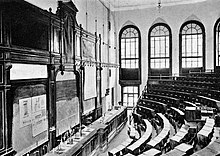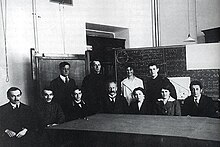Peter the Great St. Petersburg Polytechnic University
Санкт-Петербургский политехнический университет Петра Великого | |
Russian Federation | |
| Campus | Urban, city center, 102 hectares |
|---|---|
| Colours | Green/Golden |
| Nickname | Polytech |
| Mascot | Two-Headed Eagle |
| Website | www.spbstu.ru |
| University rankings | |
|---|---|
| Regional – Overall | |
| QS Emerging Europe and Central Asia[2] | 46 (2022) |
Peter the Great St. Petersburg Polytechnic University, abbreviated as SPbPU, is a
History
Imperial Russia

Saint Petersburg Polytechnic Institute was founded in 1899 as an engineering school in Russia. The main person promoting the creation of this university was the Finance Minister Count
The first director of the institute became Prince Andrey Gagarin. Unlike the French École Polytechnique, the Saint Petersburg Polytechnic Institute was always considered to be a civilian establishment. In tsarist Russia it was subordinated to the Ministry of Finance; its students and faculty wore the uniform of the ministry.[citation needed]

The main campus was built on the rural lands beyond the dacha settlement Lesnoye. The location was intended to provide some separation between the campus and the capital city of Saint Petersburg. The institute was opened to students on October 1, 1902. Originally there were four departments: Economics, Shipbuilding, Electro-mechanics and Metallurgy.[citation needed]
Its work was interrupted by the

With the onset of World War I many students found themselves in the Army and soon the number of students decreased to 3,000. Some students, like future Soviet military commander Leonid Govorov studied at the institute for one month. Part of the institute's buildings were transferred into the Maria Fyodorovna Hospital. Despite the war the institute did not stop its work.[citation needed]
In 1916
Revolution

On June 5, 1918 the institute was renamed to First Polytechnic Institute (with the Second Polytechnic Institute being the former Women's Polytechnic Institute). In November 1918
In winter of 1918/1919 there were
Soviet era
The Institute started working again in April 1920 when it became a part of the planning team for the
After the end of the
In 1930,
- Hydrotechnical (Гидротехнический),
- Industrial Civil Engineering (Институт инженеров промышленного строительства), now the Military engineering-technical university (Военный инженерно-технический универ.),
- Shipbuilding (Кораблестроительный),
- Aviation (Авиационный),
- Electrotechnical (Электротехнический),
- Chemical Technology (Химико-технологический),
- Metallurgy (Металлургический),
- Machine Building (Машиностроительный),
- Industrial Agriculture (Индустриального сельского хозяйства),
- Physics and mechanics (Физико-механического),
- Finances and Economics (Финансово-экономический) and
- Boilers and Turbines (Всесоюзный котлотурбинный).
Soon another Institute of Military Mechanics forked from the Machine Building Institute.[citation needed]
In April 1934, most of these institutes were merged back into the Leningrad Industrial Institute. In November 1940, the Institute almost got its original name back. Now it was named the Kalinin Politechnical Institute (Leningradskij Politekhnicheskij Institut imeni Kalinina) after the President of the Presidium of the Supreme Soviet Mikhail Kalinin.

With the onset of the
In 1952, Radio-physics Department was created.[
Current status
In September 1991 Leningrad returned its historical name Saint Petersburg and the Institute was renamed St. Petersburg State Technical University (the word "Technical" was changed to "Polytechnic" in 2002). Finally, in 2015, the institute took its current name Peter the Great St. Petersburg Polytechnic University.[7]
During the
World ranking
- 2022: #301 in the world in the
Students
More than 30,000 students are enrolled in the university. International students countries of origin include US, UK, France, Germany, Finland, Sweden and most of the CIS state members.[citation needed]
Department enrollment
Proportion of student body enrolled in each department, where enrollment exceeds 10%:
- Economics and Management – 23%
- Energy, Power engineering and Electrical engineering – 17%
- Metallurgy, Machinery and Materials processing – 10%[citation needed]
Campus
The campus consists of[11]
- Buildings – 112; Students dormitories – 15 buildings
- Students – 30,197 (including 2,916 foreign students)
- Teaching staff – 3,300; University staff – 5,274
Structural units
Today the Polytechnic University includes 6 associated institutes outside Saint Petersburg in the cities of Pskov, Cheboksary, Cherepovets, Sosnovy Bor, Smolensk and Anadyr.[citation needed]
- 21 faculties and institutes
- Over 150 departments, 120 R&E laboratories, 26 research and educational centers
- 3 branches and 6 representatives
- St. Petersburg College of Information and Management[citation needed]
Alumni and faculty
The University has graduated over 150,000 students. Notable alumni and faculty include:

- Nobel Prize winners Pyotr Kapitsa, Nikolay Semyonov, and Zhores Alferov
- Academicians Igor Kurchatov, Anatoly Liberman, and Georgy Flyorov
- Physicists Abram Ioffe, Aleksandr Leipunskii, and Yakov Zeldovich
- Nuclear weapon designers Nikolay Dukhov
- Aircraft designers Nikolai Polikarpov and Georgy Beriev
- T-34 tank designer Mikhail Koshkin
- Navy Admiral Aksel Berg
- Chess grandmasters David Bronstein and Russian-Israeli Dina Belenkaya
- Writers Boris Gavrilovich Gavrilov, Daniil Granin, and Yevgeny Zamyatin
- US journalist Matt Taibbi
- Theology lecturer Grigory Spiridonovich Petrov
- Former president of the Anatoly Alexandrov
- Former Turkmenistan president Saparmurat Niyazov[12]
- First cosmonaut Yuri Gagarin
- First female Azerbaijani professional metallurgist, Gjuvara Noerieva[13]
- Ice hockey executive Latvian Kirovs Lipmans[14]
Official names
The university has undergone several name changes throughout its existence. Detailed list of name changes is as following:
- 1899–1910 – Saint Petersburg Polytechnic Institute (Санкт-Петербургский политехнический институт)
- 1910–1914 – Saint Petersburg Peter the Great Polytechnic Institute (Санкт-Петербургский политехнический институт императора Петра Великого)
- 1914–1922 – Petrograd Peter the Great Polytechnic Institute (Петроградский политехнический институт императора Петра Великого)
- 1922–1923 – First Petrograd Polytechnic Institute (Первый Петроградский политехнический институт)
- 1923–1924 – Petrograd Polytechnic Institute (Петроградский политехнический институт)
- 1924–1930 – Leningrad Polytechnic Institute (Ленинградский политехнический институт)
- 1930–1934 – Divided into various colleges and branches under a variety of names.
- 1934–1940 – Leningrad Industrial Institute (Ленинградский индустриальный институт)
- 1940–1990 – Leningrad Polytechnic Institute (Ленинградский политехнический институт)
- 1990–1991 – Leningrad State Technical University (Ленинградский государственный технический университет)
- 1991–2002 – Saint-Petersburg State Technical University (Санкт-Петербургский государственный технический университет)
- 2002–2015 – Saint Petersburg State Polytechnic University (Санкт-Петербургский государственный политехнический университет)
- Since 2015 – Peter the Great St. Petersburg Polytechnic University (Санкт-Петербургский политехнический университет Петра Великого)[citation needed]
References
- ^ a b "Facts & Figures". English.spbstu.ru. Retrieved 25 July 2022.
- ^ "QS World University Rankings-Emerging Europe & Central Asia". Retrieved 15 January 2023.
- ^ "Institutes". Spbstu-eng.ru. Retrieved Jul 31, 2019.
- ^ a b "Peter the Great St. Petersburg Polytechnic University". Usnews.com.
- ^ a b "University Rankings and Student Reviews : Peter the Great St. Petersburg Polytechnic University (SPbPU)". Mastersportal.com. Retrieved 25 July 2022.
- ^ a b "Peter the Great St. Petersburg Polytechnic University Ranking 2019-2020". Center for World University Rankings (CWUR).
- ^ Decision N 407 of the Russian Ministry for Education and Science (2017) Archived 2017-09-18 at the Wayback Machine: on the status of Peter the Great St. Petersburg Polytechnic University (s. pages 4-6 in the file for chronology of renamings).
- ^ "Message from the Rector of SPbPU in connection with the situation in Ukraine". Spbstu.ru. Retrieved Mar 5, 2022.
- ^ "statement by the Rector of SPbPU in connection with the situation in Ukraine" (PDF). English.spbstu.ru. Retrieved 25 July 2022.
- ^ "Russian universities rapidly losing cooperation with West". University World News.
- ^ "Санкт-Петербургский политехнический университет Петра Великого - Высшее образование в России". Spbstu.ru.
- ^ правды», Александр ГАМОВ, Андрей СЕДОВ, Максим ЧИЖИКОВ, Ольга ВАНДЫШЕВА, Александр ЗЮЗЯЕВ, Нигина БЕРОЕВА, Кирилл АНТОНОВ | Сайт «Комсомольской (Dec 22, 2006). "Наследником Туркменбаши может стать следователь московской прокуратуры". Kp.ru -. Retrieved Jul 31, 2019.
{{cite news}}: CS1 maint: multiple names: authors list (link) CS1 maint: numeric names: authors list (link) - ^ Исмаилов, Эльдар Эльхан оглы (2009). Персидские принцы из дома Каджаров в Российской империи. М.: Старая Басманная.
{{cite book}}: Unknown parameter|agency=ignored (help) - ^ "Kirovs Lipmans". Latvian Sports (in Latvian). 2015. Retrieved 29 August 2021.
